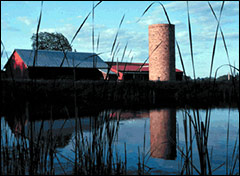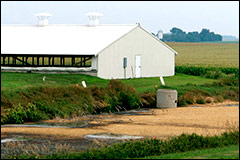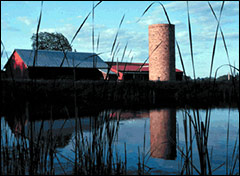
In late September, the corn and soybean fields of the lower Missouri River floodplain are a lovely dull brown, nearly ready for harvest. The row crops sprawl as far as the eye can see, their regimental march broken only by levees, gravel roads, the occasional band of cottonwoods, and the endless tracks of the Burlington Northern and Santa Fe. The scenery is pastoral and soothing. But this abundance, and the security it evokes, has a darker underside. The nation’s breadbasket, it turns out, is poisoning the water.

Farmin’ is harmin’ the water.
Photo: EPA
The Mississippi River basin, which includes the Missouri River, drains 1.83 million square miles east of the Rocky Mountains and provides drinking water to more than 18 million people. The river receives not only the effluent of all those humans, but also that of their crops and cows.
Of the many threats to drinking water in this region, which includes 65 percent of America’s cropland, farming is by far the worst.
How It All Begins
The trouble starts with a healthy rain, which washes sediment from farms, especially from row crops like corn, into waterways. Nationwide, farms lose 1.76 billion tons of topsoil each year to wind and water. The sediment can clog intake pipes at water treatment plants, make the water cloudy, and give microbes places to hide from disinfectants. By the time the Missouri River reaches Kansas City, for instance, its turbidity can be as high as 10,000 NTUs (nephelometric turbidity units). To serve this water to customers, the local utility must use chemicals and mechanical processes to lower turbidity to less than 0.1 NTU. They don’t call it the Big Muddy for nothing.
Any municipality that delivers surface water, as opposed to groundwater, deals with turbidity. It just happens to be worse in areas where the soil is regularly disturbed (as opposed to, say, a forested watershed), and nowhere is it more disturbed than in the nation’s heartland. Utilities across the country spend millions each year to meet the Environmental Protection Agency’s standards for 80 different contaminants, but every municipality addresses a unique contaminant profile: a bit of industry, a bit of ag, a bit of naturally occurring arsenic or radium. The combinations are endless. Like any utility, Kansas City Water Services treats what the river delivers. But it happens to do a better job than just about any utility in the nation. Not only does it meet and exceed federal and state standards, it does so on a daily, instead of quarterly or annual, basis.
Once you understand what’s washing downstream, the feat becomes all the more impressive.
When soil runs off the land, it also sends phosphorus and nitrogen fertilizer into ditches and streams; 6 billion pounds end up in the Mississippi and its tributaries each year. In rivers and reservoirs, these nutrients encourage the growth of algae. When algae die, bacteria feast on them, and they also consume oxygen in the water. The biotic riot sluices down to the Gulf of Mexico, where it has created an oxygen-free “dead zone” that supports no marine life. In the summer of 2007, the zone expanded from 6,000 square miles to 7,500, an area nearly the size of New Jersey.
But enough about shrimp: those algae are bad news for drinking water, too. Anaerobic conditions release iron and manganese previously bound to a river or reservoir’s bottom sediments, which causes the water’s taste, odor, and color to quickly go downhill. To deal with skunked water, plant operators dump in chemicals like potassium permanganate or copper sulfate. Dead algae and bacteria can also combine with chlorine — the mainstay of water disinfection since the early 20th century — to form nasty byproducts like trihalomethanes, which have been linked to an increased risk of bladder cancer and miscarriage.
The nitrogen itself, which converts to nitrate, is also a potential health threat to humans. In babies, nitrate binds to hemoglobin in blood and hinders its ability to deliver oxygen to the brain. In adults, high nitrate levels have been linked with increased risk of hyperthyroidism, birth defects, and miscarriage. To stay under the federal nitrate limit of 10 parts per billion, the city of Des Moines, Iowa, spent $4.5 million on an ion-exchange process that switches nitrate for chloride.
“We run it fifty to a hundred times a year,” Randy Beavers, assistant manager of Des Moines Water Works, says. “It costs us $3,000 a day.” At peak runoff, the utility just beats the cutoff, bringing levels from as high as 20 ppb down to a yearly average of 9.9 ppb. Iowa communities that drink from shallow wells, and that lack funds for fancy ion-exchange systems, have a tougher time of it. When nitrate levels spike, they issue “blue baby” alerts: kids, step away from that faucet.
The situation is bound to get worse. In 2007, farmers planted 90 million acres of corn, 15 million more than the previous year. More corn means more water contaminants.
“What we’re dealing with is a symptom of what’s happened in agriculture over the last forty years,” Chris Jones, lab supervisor at Des Moines Water Works, says. “We have these new hybrid varieties, which are designed to use a lot of nitrogen, and we plant fencerow to fencerow.” Without some upstream changes, plant officials say, the denitrification plant may soon be maxed out. The frustration of local utilities is palpable: while the federal government pours millions into agricultural subsidies, encouraging massive planting, state and local governments are stuck cleaning up the resulting mess.

Bush tours Kansas City Water Services plant in 2002.
Photo: White House.
A big part of that mess, for some downstream communities, is atrazine. Applied to corn and soybean fields in the springtime, the herbicide runs off into ditches that lead to streams that lead to drinking water uptakes. Atrazine doesn’t break down over time and distance, and there’s an increasing body of evidence that at levels far below 3 ppb (the level the U.S. EPA considers safe for humans), it’s having some spooky effects on both wild and lab-raised frogs: it causes males to grow ovaries in their testes. In some Midwestern streams, scientists with the U.S. Geological Survey have found the herbicide at up to 224 ppb.
How do drinking water plants get rid of it? “It’s a real pain,” Mike Klender, plant manager of Kansas City Water Services, says. He spends up to $180,000 a year, out of a $3-million-a-year chemical budget, buying powder-activated carbon to absorb atrazine.
Klender, a solid-looking civil engineer, strolls from his primary settling tanks, where the river comes in smelling of fish and mud, past concrete flumes to a mixing area, where the combination of lime, chlorine, ammonia, and potassium permanganate creates fluffy blobs known, to serious-minded water professionals, as “floaties.” These eventually sink, and the water strains through wooden boards into vast rectangular pools where contaminants settle for another four or five hours, turning the water (on sunny days) a delightful turquoise. Then, if it’s atrazine season, Klender adds carbon, ushering the flow over 42 inches of fine sand and gravel that “strain the remains.” Asked what he does with the atrazine he’s scrubbed out, Klender says, “We discharge it back into the river.” Next, it will be the city of Boonville’s problem.
As If That Wasn’t Enough …
In the last 20 years the Midwest has seen an explosion in the number of feedlots that keep high numbers of cattle, hogs, and poultry in close confinement. Nationwide, these animals generate roughly 500 million tons of manure a year. Farmers hold this waste in “lagoons” until they can spread it on nearby fields. But rains wash manure off fields into streams, lagoons breach, and those built before the late ’90s aren’t required to have liners.
In short: Shit seeps. And often: the Iowa Department of Natural Resources documented 329 manure spills between 1992 and 2002. Overall, according to the EPA, hog, chicken, and cattle waste has polluted 35,000 miles of rivers in 22 states and contaminated groundwater in 17.

CAFO manure lagoon.
Photo: Mark Hirsch
Manure is a source of nitrogen and phosphorus — good for crops, but, again, bad for drinking water. The manure also contains pathogens — bacteria and viruses. Vigilant drinking water plants can deal with most of this, given enough time and money. (Those who drink from private wells are on their own.) But cryptosporidium, a parasite that causes severe gastrointestinal illness in vulnerable populations, is more problematic. It’s hard to detect in water supplies — its name means hidden seed — and chlorine doesn’t neutralize it. After an outbreak killed 69 people and sickened 400,000 in Milwaukee, Wisc., in 1993, larger drinking water plants tightened their controls, but no public supplies in the world are guaranteed parasite-free. The more manure that enters streams, the higher the odds of crypto in tap water.
It’s the same with E. coli. Most types of the bacteria are harmless, but one virulent strain, called 0157:H7, is responsible for tens of thousands of cases of gastrointestinal illness in the U.S. each year. The bacteria grow in the gut of corn-fed cattle: the manure ends up in rivers or, less often, in meat. (Another route from cow to consumer is through leafy greens irrigated with highly processed wastewater from sewage treatment plants.) We eat or drink, some of us get sick, and our personal effluent ends up in a sewage treatment plant. Studies show that the 0157 strain can survive the most stringent treatment process and then evade standard tests. The sewage plants discharge into rivers and … you get the picture. The cycle of life rolls on.
Factory-farmed poultry menace drinking water, too. Their food contains arsenic, as an antimicrobial agent. A human carcinogen, arsenic ends up in chicken litter, which is spread on farm fields. From there, the metal can leach into soil and groundwater. In Prairie Grove, Ark., citizens are suing poultry owners for elevating local cancer rates to 50 times the national average. The European Union banned arsenicals from poultry production in 1988.
Confining a large number of animals in a small space increases the odds they’ll get sick. Feedlot operators hedge their bets, and enhance their animals’ growth, by lacing animal feed with antibiotics. In fact, farm animals consume 87 percent of the antibiotics in the U.S.
The drugs show up in manure, and they wash into ground- and surface water. Antibiotics don’t break down in treatment plants, and since the federal government sets no limits on these contaminants, water plant operators aren’t required to test for them. Studying bacteria found in groundwater around hog feedlots, scientists at the University of Illinois recently found several transferable genes that confer resistance to tetracycline. Should the resistance spread widely, we’d have to scratch tetracycline from our list of effective antibiotics.
Adding Ethanol Into the Mix
Water quality officials have known of the problems with fertilizers and manure for decades, and they work hard to combat them — at least when they have the funding. But the ethanol boom is bound to make their jobs harder. About a fifth of the corn planted this year will end up in ethanol plants. Environmentalists worry that farmers, tempted by high prices for the commodity, will take more than 2.5 million acres of land out of federal conservation programs — which pay them not to plant in sensitive areas — and plant even more.
“If they can make money from ethanol, they’ll do that,” Tracey Casburn, of the Missouri Department of Natural Resources, says. “It’s an economic decision.” It’s also an environmental and public-health decision, as ethanol plants impact both the quantity and quality of drinking water.
Producing ethanol requires about four gallons of water for each gallon of fuel. A typical plant produces 50 million gallons of ethanol a year, which requires 500 gallons of water a minute — or 792,000 gallons a day. Iowa water managers worry that most of the state’s 27 ethanol plants will be pulling that water from deep aquifers that provide drinking water to the state. So worried is Nebraska, the nation’s No. 3 corn producer, that state workers spend their days whacking phragmites and other water-sucking plants from their wetlands to save water for other uses.
The ethanol industry claims that more than half the water it uses either evaporates or is treated and released to streams. But the plants’ wastewater, says Susan Heathcote, water program director of the Iowa Environmental Council, “can be more like brine. They use reverse osmosis to purify their water, and they end up with high concentrations of sulfides, chloride, and iron.” Diluted in larger streams, that water is harmless, but many plants discharge into tiny creeks.
The unintended consequences of all these federal programs are boggling. In an effort to wean us from oil, the government subsidizes the planting of corn and the building of ethanol plants, both of which dirty, or diminish, drinking water. As taxpayers, you and I will pay once to support the farmers and the ethanol-makers, and then we’ll pay again when the water utility raises rates to cover the costs of more chemicals and equipment. We may pay a third time if the water fails to meet EPA standards, forcing us to buy filters or bottled water.
No one knows the exact toll that large-scale production of other plant-based fuels — cellulosic, for example — would take on drinking water, but it’s almost certain to be less harmful than our current obsession with corn. It’s hard to imagine it could be worse.
Should You Drink It?
Should you drink municipal water in the Mississippi Basin? The EPA says almost all community water systems in the region are safe for drinking (though some utilities offer caveats for infants, the elderly, and the immuno-compromised). Local utilities are required to mail every customer an annual Consumer Confidence Report: read it carefully (some of these reports are linked to the EPA’s website). Drinking from a private well? Test it for everything you can reasonably expect to seep into groundwater.
Despite government assurances, there are still reasons to distrust what comes out of your tap: the water may contain (perfectly legal) disinfection byproducts, for example, or it may be tainted with lead that leaches from your pipes (the utility’s responsibility ends where the main connects to your house). There are hundreds, if not thousands, of agricultural, industrial, and pharmaceutical contaminants in tap water that the federal government doesn’t regulate, and utilities don’t look for them because they’re under no obligation to clean them up. If you’ve got reason to suspect your water isn’t kosher, by all means buy yourself a good filter, the kind that attaches to the faucet or to under-sink pipes. Then write your legislators and demand that they tighten and enforce the discharge rules for CAFOs (that is, if they’re not willing to ban them outright); give farmers incentives to limit runoff; ban arsenicals from animal feed; curb the use of antibiotics and hormones in livestock; and push for a strong and well-funded Conservation Title in the 2007 Farm Bill. The Senate Agriculture committee is expected to begin drafting language for its version of the bill on Oct. 23; for more information on the Farm Bill and how to make your voice heard, visit the Sustainable Agriculture Coalition.
To find out more about what regulated and unregulated contaminants lurk in your tap water, check the Environmental Working Group’s National Assessment of Tap Water Quality, which examined nearly 40,000 water systems in 42 states.


